时代周刊翻译
- 格式:doc
- 大小:36.50 KB
- 文档页数:3
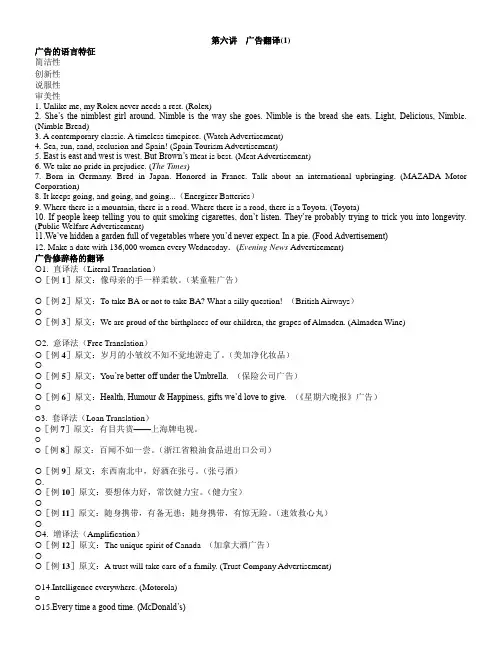
第六讲广告翻译(1)广告的语言特征简洁性创新性说服性审美性1. Unlike me, my Rolex never needs a rest. (Rolex)2. She’s the nimblest girl around. Nimble is the way she goes. Nimble is the bread she eats. Light, Delicious, Nimb le. (Nimble Bread)3. A contemporary classic. A timeless timepiece. (Watch Advertisement)4. Sea, sun, sand, seclusion and Spain! (Spain Tourism Advertisement)5. East is east and west is west. But Brown’s m eat is best. (Meat Advertisement)6. We take no pride in prejudice. (The Times)7. Born in Germany. Bred in Japan. Honored in France. Talk about an international upbringing. (MAZADA Motor Corporation)8. It keeps going, and going, and going...(Energizer Batteries)9. Where there is a mountain, there is a road. Where there is a road, there is a Toyota. (Toyota)10. If people keep telling you to quit smoking cigarettes, don’t listen. They’re probably trying to trick you into longevity. (Public Welfare Advertisement)11.We’ve hidden a garden full of vegetables where you’d never expect. In a pie. (Food Advertisement)12. Make a date with 136,000 women every Wednesday.(Evening News Advertisement)广告修辞格的翻译1. 直译法(Literal Translation)[例1]原文:像母亲的手一样柔软。
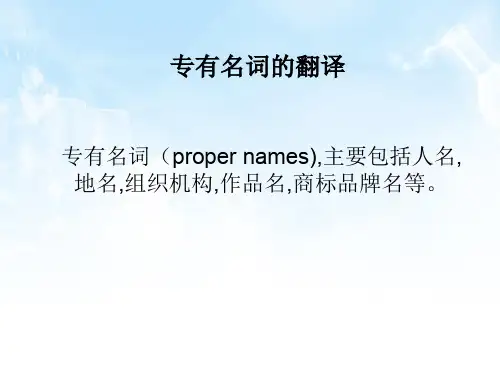
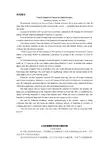
时代周刊Coal Is Linked to Cancer in China ProvincePublished: January 11, 2010Nonsmoking women in an area of China‘s Y unnan province die of lung cancer at a rate 20 times that of their counterparts in other regions of the country — and higher than anywhere else in the world.A group of scientists now say they have a possible explanation: the burning of coal formed during volcanic eruptions hundreds of millions of years ago.Coal in that part of China contains high concentrations of silica, a suspected carcinogen, the scientists reported in a recent edition of the journal Environmental Science & Technology.Like others in rural China, the families of Xuanwei County use coal for heat and for cooking. As the coal burns, particles of silica are released with the vapor and inhaled. Women, who do the cooking, face the greatest exposure.―There is more silica in this coal than in 99.9 percent of all the samples we analyzed,‖ said an author of the study, Robert B. Finkelman, a professor of geology at the University of Texas at Dallas.Dr. Finkelman and his colleagues found that quartz, of which silica is the primary component, made up 13.5 percent of the coal samples taken from Xuanwei County. In normal coal samples, quartz and other minerals are found only in trace amounts.The grains of quartz were so small they were only visible through an electron microscope, Dr. Finkelman said. Strikingly, the coal found in neighboring villages did not contain quartz at the same high levels or with such fine grain.When the volcanic eruptions occurred 250 million years ago, they set off a mass extinction and released acid gases, leading to a variety of changes in the earth‘s environment, including acid rain. Dr. Finkelman speculated that the rain might have dissolved surface rocks composed of silica, which then might have worked its way into developing formations of coal.The high cancer rates in Xuanwei have attracted the attention of scientists for decades. Dr. Qing Lan, an epidemiologist at the National Cancer Institute in Rockville, Md., is completing two studies involving hundreds of women and families there. While her team is confident that coal burning is causing the high rates of cancer, they are not certain it is due to silica.She and Dr. Nathaniel Rothman, another epidemiologist at the institute, expect to finish collecting data this year and begin the tedious, multiyear process of analyzing it in hopes of isolating just what it is about the coal in Xuanwei that causes the high rates of cancer.―Y ou can never say any study is the last study,‖ Dr. Rothman said. ―But we hope th is really nails it.‖云南宣威癌症高发疑为煤炭所致云南省宣威市。
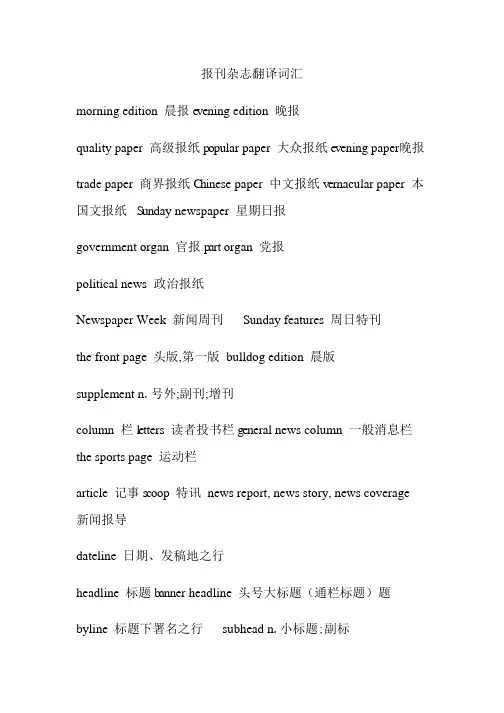
报刊杂志翻译词汇morning edition 晨报e vening edition 晚报quality paper 高级报纸p opular paper 大众报纸e vening paper晚报trade paper 商界报纸C hinese paper 中文报纸vernacular paper 本国文报纸S unday newspaper 星期日报government organ 官报p art organ 党报political news 政治报纸Newspaper Week 新闻周刊Sunday features 周日特刊the front page 头版,第一版bulldog edition 晨版supplement n.号外;副刊;增刊column 栏letters 读者投书栏general news column 一般消息栏the sports page 运动栏article 记事scoop 特讯news report, news story, news coverage 新闻报导dateline 日期、发稿地之行headline 标题b anner headline 头号大标题(通栏标题)题byline 标题下署名之行subhead n.小标题;副标feature 花絮, feature article 特写serial, to serialize 连载world news 国际新闻h ome news 国内新闻topicality 时事问题c ity news 社会新闻flash-news 大新闻big news 头条新闻hot news 最新新闻exclusive news 独家新闻advance n.预发消息;预写消息round-up n.综合消息back alley news n. 小道消息sidebar n.花絮新闻anecdote n.趣闻轶事affair n.桃色新闻;绯闻sex scandal 桃色新闻yellow sheet 低俗新闻criticism 评论editorial 社论leading article 社论review, comment 时评b ook review 书评literary criticism 文艺评论cartoon, comics 漫画c ut 插图w eather forecast 天气预报attribution n. 消息出处,消息来源news source 新闻来源informed sources 消息来源newspaper campaign 新闻战backgrounding n.新闻背景assignment n.采写任务beat n.采写范围serial story 新闻小说o bituary notice 讣闻p ublic notice 公告advertisement 广告classified ad 分类广告extra 号外newsbeat 记者采访地区news blackout 新闻管制p ress ban 禁止刊行t abloid 图片版新闻"Braille" edition 点字版newspaper office 报社news agency 新闻社publisher 发行人p r oprieter 社长b ureau chief, copy chief 总编辑editor-in-chief 总主笔e ditor 编辑, 主笔newsman, newspaperman, journalist 新闻记者reporter 采访记者cub reporter 初任记者resident correspondent 常驻记者war correspondent, campaign badge 随军记者columnist 专栏记者star reporter 一流通讯记者a ccredited journalist n. 特派记者correspondent 通讯员s pecial correspondent 特派记者contributor 投稿家commentator 评论员free-lancer writer 自由招待会p ress box 记者席n ews conference, press conference 记者招待会International Press Association 国际新闻协会distribution 发行c irculation 发行份数newsstand, kiosk 报摊newspaper agency 报纸代售处newsboy 报童s ubscription (rate)报费n ewsprint 新闻用纸F leet Street 舰队街Publication magazine 杂志periodical 期刊back number 过期杂志p re-dated 提前出版的serial story 小说连载editor's note 编者按publication 出版publishing house, press 出版社publisher 发行者c irculation 发行量e dition 版本the first edition 初版t he second edition 再版t he third edition 第三版o riginal edition 原版(书) new edition 新版r evised edition 修订版reprint 重印, 翻印the first impression 第一次印刷the second impression 第二次印刷de luxe edition 精装本p aperback 平装本p ocket edition 袖珍本popular edition 普及版c opyright 版权royalty 版税type-setting, composition 排版proof-reading 校对工作proof-reader 校对(者)printing 印刷p rinting machine 印刷机type-setter, compositor 排字工人folio 对开本quarto 四开本octavo 八开本16-mo 十六开本32-mo 三十二开本64-mo 六十四开本reference book 参考书b ooklet, pamphlet 小册子, 小书periodical 期刊magazine 杂志daily 日报w eekly 周刊f ortnightly 半月刊monthly 月刊b imonthly 双月刊quarterly 季刊a nnual 年刊year-book 年鉴e xtra issue (报纸)号外special issue 特刊manual, handbook 手册document. paper 公文pictorial magazine 画报memorial volume 纪念刊selected works, selections 选集complete works 全集anthology 文集, 文选scientific literature 科学文献index 索引cheap edition, paperback 廉价本encyclopaedia, encyclopedia 百科全书textbook 教科书reader 读本best seller 畅销书Bad news travels quickly. 坏事传千里。
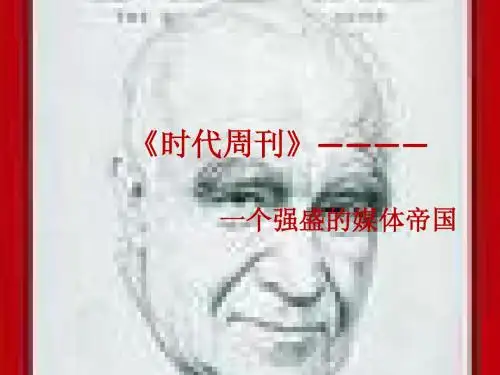
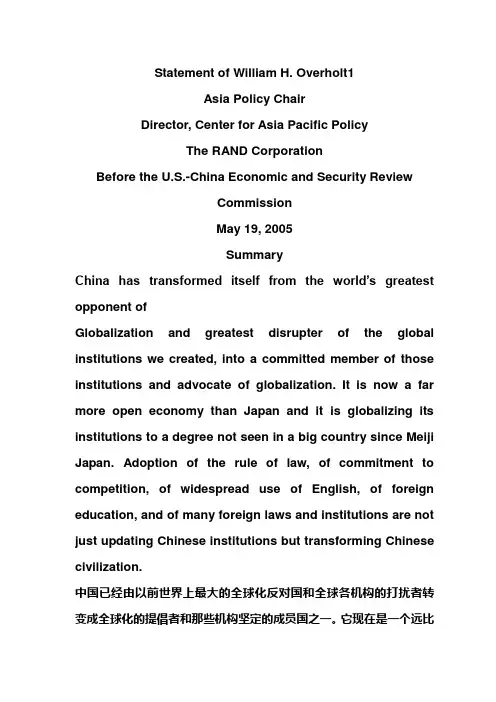
Statement of William H. Overholt1Asia Policy ChairDirector, Center for Asia Pacific PolicyThe RAND CorporationBefore the U.S.-China Economic and Security ReviewCommissionMay 19, 2005SummaryChina has transformed itself from the world’s greatest opponent ofGlobalization and greatest disrupter of the global institutions we created, into a committed member of those institutions and advocate of globalization. It is now a far more open economy than Japan and it is globalizing its institutions to a degree not seen in a big country since Meiji Japan. Adoption of the rule of law, of commitment to competition, of widespread use of English, of foreign education, and of many foreign laws and institutions are not just updating Chinese institutions but transforming Chinese civilization.中国已经由以前世界上最大的全球化反对国和全球各机构的打扰者转变成全球化的提倡者和那些机构坚定的成员国之一。
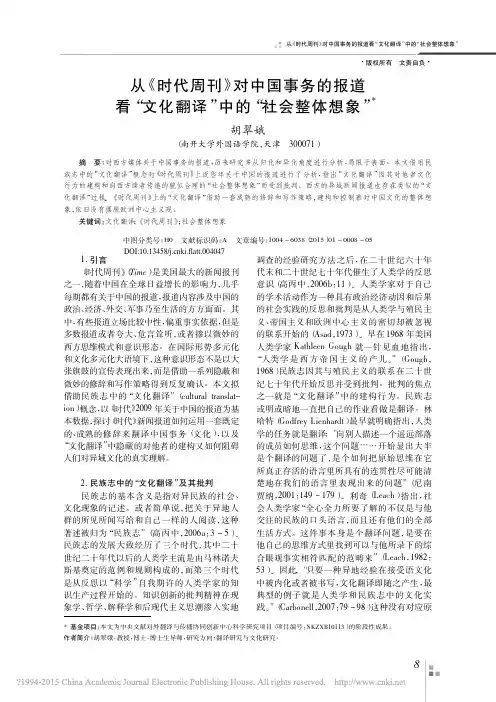
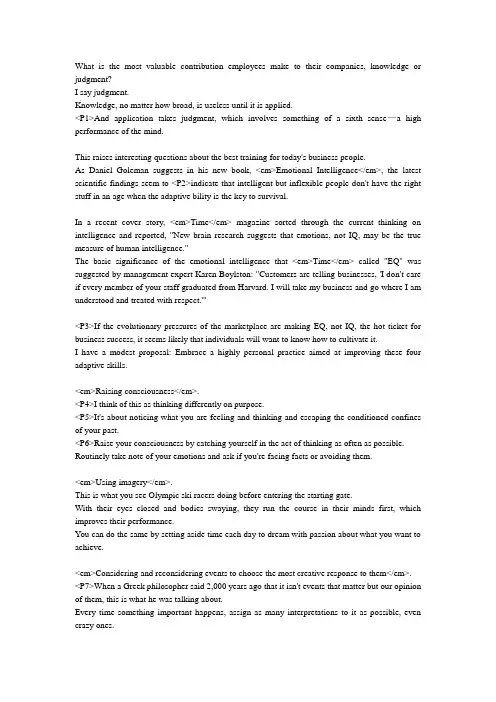
What is the most valuable contribution employees make to their companies, knowledge or judgment?I say judgment.Knowledge, no matter how broad, is useless until it is applied.<P1>And application takes judgment, which involves something of a sixth sense—a high performance of the mind.This raises interesting questions about the best training for today's business people.As Daniel Goleman suggests in his new book, <em>Emotional Intelligence</em>, the latest scientific findings seem to <P2>indicate that intelligent but inflexible people don't have the right stuff in an age when the adaptive bility is the key to survival.In a recent cover story, <em>Time</em> magazine sorted through the current thinking on intelligence and reported, "New brain research suggests that emotions, not IQ, may be the true measure of human intelligence."The basic significance of the emotional intelligence that <em>Time</em> called "EQ" was suggested by management expert Karen Boylston: "Customers are telling businesses, 'I don't care if every member of your staff graduated from Harvard. I will take my business and go where I am understood and treated with respect.'"<P3>If the evolutionary pressures of the marketplace are making EQ, not IQ, the hot ticket for business success, it seems likely that individuals will want to know how to cultivate it.I have a modest proposal: Embrace a highly personal practice aimed at improving these four adaptive skills.<em>Raising consciousness</em>.<P4>I think of this as thinking differently on purpose.<P5>It's about noticing what you are feeling and thinking and escaping the conditioned confines of your past.<P6>Raise your consciousness by catching yourself in the act of thinking as often as possible. Routinely take note of your emotions and ask if you're facing facts or avoiding them.<em>Using imagery</em>.This is what you see Olympic ski racers doing before entering the starting gate.With their eyes closed and bodies swaying, they run the course in their minds first, which improves their performance.You can do the same by setting aside time each day to dream with passion about what you want to achieve.<em>Considering and reconsidering events to choose the most creative response to them</em>. <P7>When a Greek philosopher said 2,000 years ago that it isn't events that matter but our opinion of them, this is what he was talking about.Every time something important happens, assign as many interpretations to it as possible, even crazy ones.Then go with the interpretation most supportive of your dreams.<em>Integrating the perspectives of others</em>.Brain research shows that our view of the world is limited by our genes and the experiences we've had.<P8>Learning to <1>incorporate</1> the useful perspectives of others is nothing less than a form of enlarging your senses.The next time someone interprets something differently from you—say, a controversial political event—pause to reflect on the role of life experience and consider it a gift of perception.<P9>The force of habit—literally the established wiring of your brain—will pull you away from practicing these skills.Keep at it, however, because they are based on what we're learning about the mechanism of the mind.Within the first six months of life the human brain doubles in capacity.It doubles again by age four and then grows rapidly until we reach sexual maturity.The body has about a hundred billion nerve cells, and every experience <2>triggers</2> a brain response that literally shapes our senses.The mind, we now know, is not confined to the brain but is distributed throughout the body's universe of cells.Yes, we do think with our hearts, brains, muscles, blood and bones.During a single crucial three-week period during our teenage years, chemical activity in the brain is cut in half.<P10>That done, we are "biologically wired" with what one of the nation's leading brain researchers calls our own "world view".He says it is impossible for any two people to see the world exactly alike.So unique is the personal experience that people would understand the world differently.However, it is not only possible to change your world view, he says, it's actually easier than overcoming a drug habit.<P11>But you need a discipline for doing it.Hence, the method recommended here.<P12>No, it's not a curriculum in the sense that an MBA is.But the latest research seems to imply that without the software of emotional maturity and self-knowledge, the hardware of academic training alone is worth less and less.员工对公司最有价值的贡献是什么,是知识还是判断力?我说是判断力。
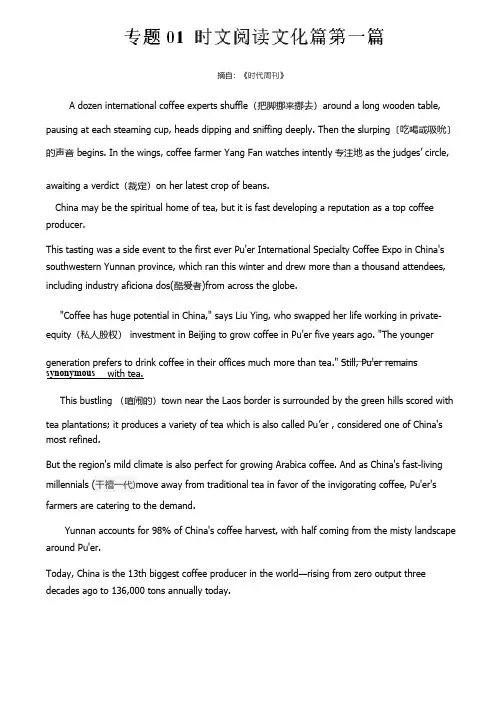
摘自:《摘自:《时代周刊时代周刊》A dozen international coffee experts shuffle (把脚挪来挪去)around a long wooden table, pausing at each steaming cup, heads dipping and sniffing deeply. Then the slurping 〔吃喝或吸吮〕的声音 begins. In the wings, coffee farmer Yang Fan watches intently 专注地as the judges’ circle, awaiting a verdict (裁定)on her latest crop of beans.China may be the spiritual home of tea, but it is fast developing a reputation as a top coffee producer.This tasting was a side event to the first ever Pu'er International Specialty Coffee Expo in China's southwestern Yunnan province, which ran this winter and drew more than a thousand attendees, including industry aficiona dos(酷爱者)from across the globe."Coffee has huge potential in China," says Liu Ying, who swapped her life working in private-equity (私人股权) investment in Beijing to grow coffee in Pu'er five years ago. "The younger generation prefers to drink coffee in their offices much more than tea." Still, Pu'er remains synonymous with tea.This bustling (喧闹的)town near the Laos border is surrounded by the green hills scored with tea plantations; it produces a variety of tea which is also called Pu tea plantations; it produces a variety of tea which is also called Pu’’er , considered one of China's most refined.But the region's mild climate is also perfect for growing Arabica coffee. And as China's fast-living millennials (千禧一代)move away from traditional tea in favor of the invigorating coffee, Pu'er's farmers are catering to the demand.Yunnan accounts for 98% of China's coffee harvest, with half coming from the misty landscape around Pu'er.Today, China is the 13th biggest coffee producer in the world Today, China is the 13th biggest coffee producer in the world——rising from zero output three decades ago to 136,000 tons annually today.In April, Seattle's annual Specialty Coffee Expo decided to showcase China as its portrait country of origin.It follows on the heels of Starbucks' launching its first single-origin Yunnan coffee last year after eight years of partnership with Yunnan farmers.With global coffee prices at record lows, Yunnan farmers are processing beans in bespoke ways to create distinct flavors——allowing them to enter the market of specialty coffee.to create distinct flavors"At current coffee prices, I can't even feed my family," says the farmer Yang. "My only wayout is to produce specialty coffee, to make the best coffee beans."That means letting beans dry in their cherries, thus producing a wild, fruity flavor via environmental fermentation(发酵),or allowing them to "honey" in their sugary inner layer, which adds a subtle sweetness.Back in the tasting room, Yang awaits the experts' verdict on whether all that extra effort was worthwhile."If I told you this was Colombian or Panama coffee, nobody would argue with me," says Samuel Gurel, CEO of Pu'er's Torch Coffee Roasters, as Yang breaks into a huge grin. "It's a great example of how Chinese coffee is evolving."阅读词汇分类记I. 识读词汇(要求认识;快速反应汉语意思)1.Specialty ['spɛʃəlti]n. 专业,专长;特产;特性;招牌菜adj. 特色的;专门的;独立的His specialty is international law.他的专业是国际法。
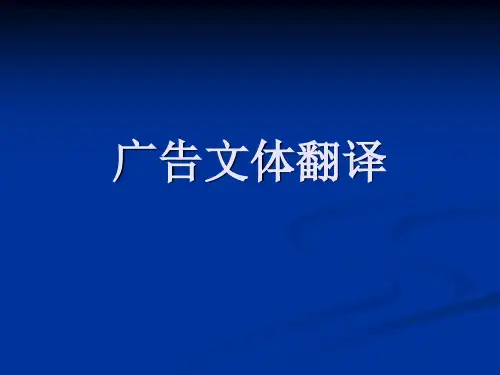
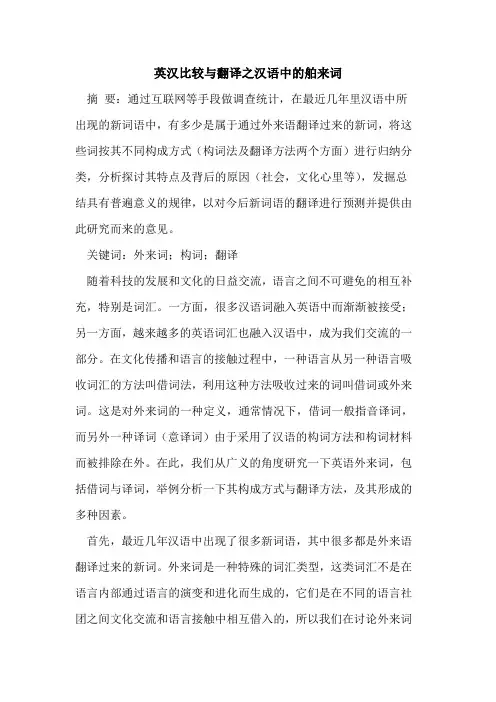
英汉比较与翻译之汉语中的舶来词摘要:通过互联网等手段做调查统计,在最近几年里汉语中所出现的新词语中,有多少是属于通过外来语翻译过来的新词,将这些词按其不同构成方式(构词法及翻译方法两个方面)进行归纳分类,分析探讨其特点及背后的原因(社会,文化心里等),发掘总结具有普遍意义的规律,以对今后新词语的翻译进行预测并提供由此研究而来的意见。
关键词:外来词;构词;翻译随着科技的发展和文化的日益交流,语言之间不可避免的相互补充,特别是词汇。
一方面,很多汉语词融入英语中而渐渐被接受;另一方面,越来越多的英语词汇也融入汉语中,成为我们交流的一部分。
在文化传播和语言的接触过程中,一种语言从另一种语言吸收词汇的方法叫借词法,利用这种方法吸收过来的词叫借词或外来词。
这是对外来词的一种定义,通常情况下,借词一般指音译词,而另外一种译词(意译词)由于采用了汉语的构词方法和构词材料而被排除在外。
在此,我们从广义的角度研究一下英语外来词,包括借词与译词,举例分析一下其构成方式与翻译方法,及其形成的多种因素。
首先,最近几年汉语中出现了很多新词语,其中很多都是外来语翻译过来的新词。
外来词是一种特殊的词汇类型,这类词汇不是在语言内部通过语言的演变和进化而生成的,它们是在不同的语言社团之间文化交流和语言接触中相互借入的,所以我们在讨论外来词的构成上不能按照常规的复合法、转换法、派生法、缩略发等构词方法。
在此,我们按其借入方式将其分为音译、意译及半音半意三类,再结合其文化特点谈谈其翻译规律。
一、音译借词的特点及翻译。
音译借入方式引进的外来词在英语和汉语中都不少,汉语中的音译外来词的方式主要是引进英语等印欧语系中的专有名词,例如,奥巴马(obama),华盛顿(washington),香奈儿(chanel),贝令妃(benefit)﹝英国知名化妆品品牌﹞等;也有一些非专有名词,如幽默(humor),尼龙(nylon),白兰地(brandy),engine(引擎),motor(马达),拷贝(copy),磅(pound),秀(show)和脱口秀(talk show),克隆(clone),镭射(laser),迷你(mini),以及粉丝(fans),比基尼(bikini)等。
Unit 21.在中秋节,我们将会赏月、吃月饼。
(admire)During the Mid-autumn Day, we will admire the moon and enjoy mooncakes.2.请给我两个随时可以联系到的人员的名字。
(contact)Give the names of two people who can be contacted at any time.3.新建的学校图书馆将是我们一个有用的信息来源。
(source)The newly built school library will be a useful source of information for us.4.这些货物(goods)是通过铁路和水路运输的。
(transport)These goods were transported by rail and water.5.对于长途旅行而言,乘飞机是到达你的目的地的最快方式。
(destination)For a long distance, air travel is the fastest way to get to your destination.6.士兵们疲惫不堪。
(extreme)The soldiers were extremely tired.7.你是这么有影响力的人,以至于人们都会听你的。
(power)You are such a powerful man that people will listen to you.8.令人惊讶的是,这男孩能这么快就解出这道题。
(It’s… that…; amaze)It was amazing that the boy was able to solve the problem so quickly.9.教育对一个国家经济发展的重要性得到了人们的认可。
(It is recognized that…)It is recognized that education is important to a country’s economic development.10.你度假的费用(price)包含(include)旅馆住宿。
ally[['ælaɪ]]n. 同盟国;伙伴;同盟者;助手vt. 使联盟;使联合vi. 联合;结盟网络释义Ally:伙伴| 阿莉| 盟国rigidity[[rɪ'dʒɪdətɪ]]基本翻译n. [物] 硬度,[力] 刚性;严格,刻板;僵化;坚硬网络释rigidity:刚性| 硬度| 刚度cognitive therapy基本翻译认知疗法网络释义cognitive therapy:认知疗法| 认知治疗| 认知治疗法perspective [[pə'spektɪv]]基本翻译n. 观点;远景;透视图adj. 透视的网络释义Perspective:透视| 观点| 透视画法point of view基本翻译观点;见地;立场网络释义point of view:观点| 视点| 视角viscerally基本翻译adv. visceral的变形网络释义viscerally:发自内心cultivating基本翻译v. 培养(cultivate的现在分词)网络释义cultivating:力求与人交往| 培养| 耕种supple [['sʌp(ə)l]]基本翻译adj. 柔软的;灵活的;顺从的;易弯曲的;逢迎的vt. 使柔软;使顺从vi. 变柔顺;变柔软网络释义Supple:柔顺的| 柔软| 质地不硬inability to基本翻译没有...的能力网络释义inability to:无能| 无力的options基本翻译n. 选择;期权;选择项(option的复数)v. 给予的销售权;为提供选择供应的附件(option的三单形式)网络释义Options:选项| 设置| 期权optionsLenovo also sells some of the building block components as standalone accessories. When sold stand...fosters基本翻译v. 培养;促进(foster的第三人称单数)网络释义Fosters:福士啤| 培养| 莱斯特foible [['fɒɪb(ə)l]]基本翻译n. 弱点;小缺点;癖好网络释义foible:小缺点| 弱点| 缺点sarcasm [['sɑːkæz(ə)m]]基本翻译n. 讽刺;挖苦;嘲笑网络释义sarcasm:讽刺| 挖苦| 嘲笑playful [['pleɪfʊl; -f(ə)l]]基本翻译adj. 开玩笑的;幽默的;爱嬉戏的网络释义Playful:游戏| 好玩的| 顽皮的embrace [[ɪm'breɪs; em-]]基本翻译vt. 拥抱;信奉,皈依;包含n. 拥抱vi. 拥抱网络释义embrace:拥抱| 包括| 包围at the expense of基本翻译以为代价;由支付费用网络释义at the expense of:以为代价| 在损害情况下| 付费distinction [[dɪ'stɪŋ(k)ʃ(ə)n]]基本翻译n. 区别;差别;特性;荣誉、勋章网络释义distinction:区别| 差别| 级别百科distinctiondistinctionAHD:【d¹-st¹ngk“sh…n】D.J.:【di6sti0k.*n】K.K.:【d!6st!0k.*n】n.The act of distingu...distraught [[dɪ'strɔːt]]基本翻译adj. 发狂的;心烦意乱的网络释义distraught:心神分散| 心烦意乱的| 发狂的inherent [[ɪn'hɪər(ə)nt; -'her(ə)nt]]基本翻译adj. 固有的;内在的;与生俱来的,遗传的网络释义inherent:固有的| 内在的| 与生俱来的farce [[fɑːs]]基本翻译n. 闹剧;胡闹;笑剧网络释义farce:闹剧| 滑稽戏| 滑稽剧bearable [['beərəb(ə)l]]基本翻译adj. 可忍受的;支持得住的网络释义bearable:支持得住的| 可忍受的| 支援得住的traits基本翻译n. 特性,特质,性格(trait的复数)网络释义Traits:特质| 特性| 特征goofy [['guːfɪ]]基本翻译adj. 傻瓜的,愚笨的网络释义Goofy:高飞| 拗脚| 高飞狗puncture [['pʌŋ(k)tʃə]]基本翻译n. 穿刺;刺痕vt. 刺穿;揭穿;削弱vi. 被刺穿;被戳破网络释义puncture:穿刺| 刺破| 片rigid [['rɪdʒɪd]]基本翻译adj. 严格的;僵硬的,死板的;坚硬的;精确的网络释义rigid:严格的| 刚性的| 刚硬的paradoxical intention基本翻译矛盾意向;矛盾疗法网络释义paradoxical intention:矛盾意向| 矛盾意向法| 矛盾疗法wretch [[retʃ]]基本翻译n. 可怜的人,不幸的人;卑鄙的人网络释义wretch:无名小站| 悲惨| 不幸的人doomed [[du:md]]基本翻译adj. 注定的;命定的v. 注定;宣判(doom的过去分词)网络释义Doomed:注定| 命中注定的| 命定的subhuman [[sʌb'hjuːmən]]基本翻译adj. 类人的;近似人类的;低于人类的网络释义subhuman:低于人类的| 近似人类的| 不适合人类的exaggeration [[iɡ,zædʒə'reiʃən]]基本翻译n. 夸张;夸大之词;夸张的手法网络释义exaggeration:夸张| 夸大| 夸张效果absurdity [[əb'sɜːdɪtɪ]]基本翻译n. 荒谬;谬论;荒谬的言行网络释义absurdity:荒唐| 谬论| 荒谬far too基本翻译极其非常远远网络释义far too:非常| 极其| 太disgruntled [[dɪs'ɡrʌntld]]基本翻译adj. 不满的;不高兴的网络释义disgruntled:不满的| 不高兴的| 不满意的leak in基本翻译漏入turnover [['tɜːnəʊvə]]基本翻译n. 翻覆;营业额;流通量;半圆卷饼;[篮球]失误adj. 翻过来的;可翻转的网络释义turnover:营业额| 失误| 人员流动inflating [[in'fleitiŋ]]基本翻译adj. 膨胀的;充气的v. 膨胀;充气(inflate的ing形式)n. 充气;加压网络释义Inflating:吹大| 胎压| 加压fold [[fəʊld]]基本翻译n. 折痕;信徒;羊栏vi. 折叠起来;彻底失败vt. 折叠;合拢;抱住;笼罩网络释义fold:折叠| 褶皱| 弃牌to demonstrate基本翻译演示;示范网络释义to demonstrate:解释| 显示|tone (in) with基本翻译(尤指颜色)与协调;与和谐:proffer [['prɒfə]]基本翻译n. 提供;提出;提议vt. 提供;提出;奉献网络释义proffer:提供| 提出| 贡献restoring基本翻译adj. 恢复的v. 恢复,重建;正在恢复(restore的现在分词)网络释义restoring:恢复的| 数据库正在恢复| 恢复力矩strive for基本翻译争取,奋斗网络释义strive for:为| 谋求| 争取equitably [['ekwitəbli]]基本翻译adv. 公正地网络释义equitably:公正地| 公平地over time基本翻译随着时间的过去;超时网络释义Over time:久而久之| 加班| 随着时间的过去百科time美国著名出版刊物《时代》(又译《时代周刊》、《时代杂志》;英语:TIME),被誉为当代最具代表性... 详细»搜索time time歌词counterintuitive [[,kaʊntərɪn'tjuːɪtɪv]]基本翻译adj. 违反直觉的网络释义counterintuitive:反直觉的| 违反直觉的| 直觉in the loop基本翻译在消息圈内;在决策圈内;在参与机密的智囊团内网络释义In the Loop:灵通人士| 表示圈内的| 在循环中影视资讯in the loop (2009) 剧情剧评类型:喜剧导演:阿曼多·兰努奇主演:詹姆斯·甘多菲尼汤姆·霍兰德克里斯·阿迪森评分:7.6 / 10搜索in the loop loopgloss over基本翻译v. 掩盖,掩饰;给以光滑的表面网络释义gloss over:掩饰| 给以光滑的表面| 掩盖bedrock [['bedrɒk]]基本翻译n. [地质] 基岩;根底;基本原理网络释义bedrock:基岩| 基层岩| 岩床百科bedrockDJ:John Creamer & Stephane K专辑:Bedrock风格:House公司:Bedrock Records 时间:2002/9/6来自纽约的DJ双拍档John Creamer及... 详细»搜索bedrockfavoritism [['fevərɪt,ɪzəm]]基本翻译n. 偏袒;得宠网络释义favoritism:偏爱| 偏袒| 受偏爱concrete form基本翻译[计] 具体形式;浇混凝土用的模板网络释义concrete form:浇混凝土用模板| 浇混凝土用的模板| 混凝土模板exclusion [[ɪk'skluːʒ(ə)n; ek-]]基本翻译n. 排除;排斥;驱逐;被排除在外的事物网络释义exclusion:排除| 排斥| 排斥性。
2019年6月CATTI二级笔译实务参考答案及全面解析(1)第一篇英译汉In 2009, Time magazine hailed an online math program piloted at three New York City public schools, as one of the year’s 50 best innovations. Each day, the software generated individualized math “playlists” for students who then chose the “modality” in which they wished to learn — software, a virtual teacher or a flesh-and-blood one. A different algorithm sorted teachers’ specialties and schedules to match a student’s needs. “It generates the lessons, the tests and it grades the tests,” one veteran instructor marveled.解析:不是《时代杂志》,而是《时代周刊》。
原文的理解不是停留在表层,而是深入理解原文的意义、内涵、句法结构和逻辑思路。
具体体现在某些单词的指代要清晰,词语选择要到位。
the software generated individualized math “playlists” for students who then chose the “modality” in which they wished to learn 在这里看到the software前面的the就要知道指代前文提到的在线数学授课程序。
Unit5课文翻译事实如此,我们孤独无依地生活着。
据最近的统计,共有2,200万人独自生活在自己的住所里。
其中有些人喜欢这种生活,有些却不喜欢。
有些离了婚,有些鳏寡无伴,也有些从未结过婚。
孤独或许是这里的一种民族弊病,我们羞于承认它,甚于其他任何罪恶。
而另一方面,故意选择独处,拒绝别人的陪伴而非为同伴所弃,却是美国式英雄的一个特点。
孤独的猎人或探险者去鹿群和狼群中冒险,征服广袤的荒野时,并不需要有人陪伴。
梭罗独居在湖畔的小屋,有意疏离了城市生活。
现在,这成了你的个性。
独处的灵感是诗人和哲学家最有用的东西。
他们都赞成独处,都因能够独处而自视甚高,至少在他们匆忙赶回家喝茶之前的一两个小时之内是这样。
就拿多萝西·华兹华斯来说吧,她帮哥哥威廉穿上外衣,为他找到笔记本和铅笔,向他挥手告别,目送他走进早春的阳光去独自对花沉思。
他写道:“独处多么优雅,惬意。
”毫无疑问,如果自愿独处,感觉要好得多。
看看弥尔顿的女儿们:她们为他准备好垫子和毯子,然后蹑手蹑脚地走开,以便他能创作诗歌。
然而他并不自己费神将诗歌写下来,而是唤回女儿们,向她们口述,由她们记下来。
也许你已经注意到,这些艺术家类型的人,大多是到户外独处,而家里则自有亲人备好了热茶,等着他们回家。
美国的独处代表人物是梭罗。
我们钦佩他,并非因为他能自力更生,而是因为他孤身一人在瓦尔登湖畔生活,他喜欢这样──独居在湖畔的树林中。
实际上,他最近的邻居离他只有一英里,走路也就20分钟;铁路离他半英里;交通繁忙的大路距他300码。
整天都有人进出他的小屋,请教他何以能够如此高洁。
显然,他的高洁之处主要在于:他既没有妻子也没有仆人,自己动手用斧头砍柴,自己洗杯洗碟。
我不知道谁为他洗衣服,他没说,但他也肯定没提是他自己洗。
听听他是怎么说的:“我从未发现比独处更好的伙伴。
”梭罗以自尊自重为伴。
也许这里的启示是:自我意识越强,就越不需要其他的人在周围。
我们越是感觉谦卑,就越受孤独的折磨,感到仅与自己相处远远不够。
CET6真题高频词汇大解析(三)Ascribe(8次)1. Police and villagers unanimously __the forest fire to thunder and lightning. (05/12)A) ascribedB) approachedC) confinedD) confirmed2. The police are trying to ________ what really happened. (04/6)A) ascertainB) assertC) avertD) ascribe3. Many great scientists ____ their success to hard work.?(03/12)A) portrayB) ascribeC) impartD) acknowledge4. More than 85 percent of French Canada's population speaks French asa mother tongue and _______ to the Roman Catholic faith. (02/12)A) catersB) adheresC) ascribesD) subscribes5. It was ____ that the restaurant discriminated against black customers. (02/6)A) addictedB) allegedD) ascribed6. We should ________ our energy and youth to the development of our country. (02/1)A) dedicateB) caterC) ascribeD) cling7. You should ________ to one or more weekly magazines such as time, or Newsweek. (01/6)A) ascribeB) orderC) reclaimD) subscribe8. The famous scientist _______his success to hard work.(00/1)A) impartedB) grantedC) ascribedD) acknowledgedAllege(3次)1. Allen will soon find out that real life is seldom as simple as it is _____ in commercials. (03/6)A) permeatedB) allegedC) depictedD) drafted2. It was ____ that the restaurant discriminated against black customers. (02/6)A) addictedC) assaultedD) ascribed3. The suspect ______ that he had not been in the neighbourhood at the time of the crime. (00/6)A) advocatedB) allegedC) addressedD) announcedAmbitious(3次)1. Their diplomatic principles completely laid bare their ________ for world conquest.?(01/1)A) admirationB) ambitionC) administrationD)orientation2. My sister is quite _______ and plans to get an M. A. degree within one year. (00/1)A) aggressiveB) enthusiasticC) considerateD) ambitious3. The directions were so _______ that it was impossible to complete the assignment. (98/6)A) ingeniousB) ambitiousC) notoriousD) ambiguousAmend(2次)1. I found it difficult to _____ my career ambitions with the need to bring up my children. (03/6)A) consolidateB) amendC) reconcileD) Intensify2. Mike just discovered that his passport had _______ three months ago. (99/6)A) abolishedB) expiredC) amendedD) constrainedApt(2次)1. Even sensible men do ____ things sometimes. (02/6)A) abruptB) absurdC) acuteD) apt2. Shoes of this kind are ________ to slip on wet ground. (02/1)A) feasibleB) appropriateC) aptD) fittingAscribe:AABBB ADCAllege:CBBAmbitious:BDDAmend:CBApt:BC高频词讲解:Ascribe共出现8次,作为主考词3次,陪考词5次。
…Back to Sleep‟: Why Are 2,500 U.S. Babies Still Dying of SIDS Each Year?‘用背部睡觉’:为什么美国每年都有2500个婴儿死于婴儿猝死综合症Putting babies on their back to sleep has dramatically reduced the number of SIDS deaths, but thousands of babies still die each year. A look at the key risk factors.让婴儿用背部睡觉戏剧性的减少了婴儿猝死综合症的死亡数量,但每年还是有上千数量的婴儿死亡。
这有一种对于关键的风险因素的看法。
There‟s no doubt that the Back to Sleep campaign launched in 1994 to get parents to stop putting babies to sleep on their tummies has been a success. In the 1970s and 1980s, the rate of infant deaths per 1,000 live births was 1.5; it‟s now 0.5.无需置疑的是,1994年发起的用背部睡觉的运动,旨在阻止父母让婴儿用肚子睡觉是成功的。
在20世纪70到80年代,婴儿死亡率为每一千名安全出生婴儿中有1.5,现在是0.5。
Within a generation, most babies are now put to bed on their backs, and yet 2,500 U.S. infants still die each year in the U.S. Researchers trying to understand why have noticed a curious byproduct of the trend towardback-sleeping: as fewer babies were being put to sleep on their bellies, more babies were documented engaging in other pediatric no-nos — sleeping with their parents, for example — which is another risk factor for SIDS.在一代人中,大部分婴儿现在都用背部放在床上,但美国每年依然有2500个婴儿死亡。
研究员正试图弄明白为什么人们会注意到用背部睡觉这种趋势的奇怪的副产品:越来越少的婴儿用腹部睡觉,越来越多的婴儿被证明参与到了一些儿科禁止的事情中——例如,和父母一起睡——这是婴儿猝死综合症的另一个风险因素。
A study published Monday in the journal Pediatrics takes a look at how risk factors for SIDS have evolved over the years. In an analysis of the 954 babies who died suddenly and unexpectedly in San Diego County between 1991 and 2008 — 568 of these deaths were attributed to SIDS — researchers found thatthe percentage of babies put to sleep on their backs increased from 30% to 85%. Meanwhile, the rate of bed-sharing at the time of a SIDS death jumped from 19% to 38%; the incidence of babies asleep in an adult bed instead of in a crib increased from 23% to 45%. Being put to sleep in a standard bed is concerning to doctors because beds generally have generous amounts of bedding — fluffy pillows and layers of blankets — which can lead to infant suffocation.周一在儿科杂志出版的一个课题研究了婴儿猝死综合症的风险因素在这些年是如何进化的。
在1991年和2008年之间的一份关于圣地亚哥出乎意料猝死的954个婴儿的分析中——死亡人数中有568人被确定死于婴儿猝死综合症——研究员发现,用背部睡觉的婴儿的百分比从30%增长到85%。
其间,婴儿猝死综合症的死亡人数中,同睡一张床所占的比例由19%跃升到38%;婴儿在大人的床上睡着而不是在婴儿床睡着的死亡发生率从23%增长到45%。
就医生而言,睡在标准床上是因为床上一般都有大量的床上用品——松软的抱枕和毛毯——这些都会导致婴儿窒息死亡。
Risk factors for SIDS include being born prematurely, being male and being exposed prenatally to alcohol or cigarettes; after birth, parents can unwittingly pile on other risk factors, such as overbundling baby or tucking him in for the night with a cozy quilt. When analyzing the data, lead author Henry Krous, a pediatric pathologist and director of the San Diego SIDS Research Project at Rady Children‟s Hospital, noticed that the number of risk factors hadn‟t actually decreased; it had just changed. “Most babies had two or more risk factors,” says Krous. “What that says to us is that Back to Sleep should emphasize multiple risk factors.”婴儿猝死综合症的风险因素包括过早出生,出生前接触酒精和香烟;出生后,父母在不知不觉中又让婴儿处在其他的风险因素上,比如婴儿捆绑过度或把他整晚压在舒适的棉被里。
当分析这些数据时,第一作者亨利克劳斯,儿科病理学家、圣地亚哥雷迪儿童医院婴儿猝死综合症研究项目主管,发现风险因素的数量实际上并没有减少;它只是改变了。
“大多数婴儿都存在两个或更多的风险因素,”克劳斯说,“这要告诉我们的是用背部睡觉运动应该强调预防多种多样的风险因素。
”In other words, Back to Sleep should stress much more than justback-sleeping. Just putting a baby on his back at bedtime is not the entire solution; parents bringing a new baby home from the hospital should be educated about avoiding baby‟s exposure to all the risk factor s for SIDS.换句话说,用背部睡觉运动应该强调更多而不仅仅只是用背部睡觉。
仅仅是让婴儿在睡觉时间用背部睡觉并不是全部的解决方法;父母从医院带回新生儿的时候就应该被教育如何避免让婴儿暴露在婴儿猝死综合症的风险因素中。
(MORE: New Guidelines: How to Put Baby Safely to Bed)新的指导方法:如何安全的把婴儿放到床上Co-sleeping, for example, is associated with a greater risk of SIDS, so much so that Milwaukee last year launched a graphic blitz against the practice, with posters showing babies asleep in adult beds right next to butcher knives. The caption: “Your baby sleeping with you can be just as dangerous.” As withalm ost any parenting practice, the issue isn‟t straightforward: proponents insist that bed-sharing — when done correctly — can be safe.例如,一起睡是婴儿猝死综合症的巨大风险的关联,以至于密尔沃基去年发起了一场形象与实践的闪电战,海报展示的是婴儿在屠夫的刀旁边的成人床里睡着了。
标题上写着:“你的孩子和你睡在一起很可能成为危险。
”就像所有的育儿实践一样,问题并不是简单的支持者坚持同床睡——只要做得正确——就可以变得安全。
Furthermore, despite the prevailing message of Back to Sleep, 30% of babies are still being put to bed on their bellies. “We still have a lot of work to do,” says Krous. “The problem isn‟t solved yet.”此外,轻视现在盛行的用背部睡觉的运动,仍有30%的婴儿还在用腹部放在床上。